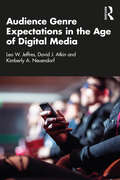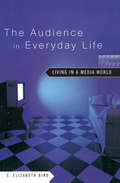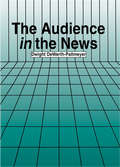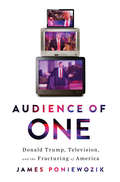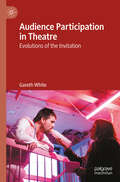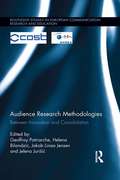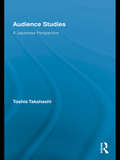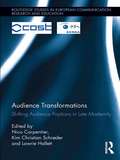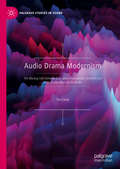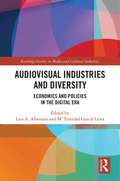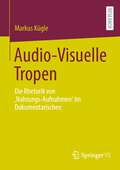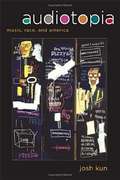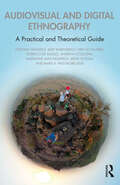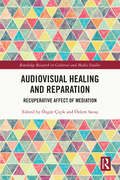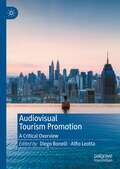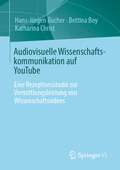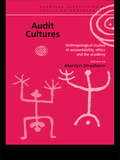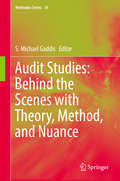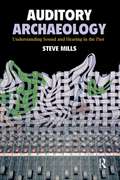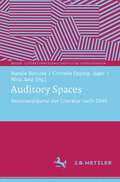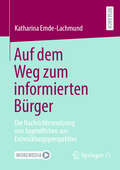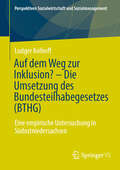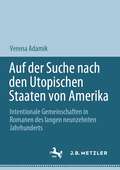- Table View
- List View
Audience Genre Expectations in the Age of Digital Media
by Leo W. Jeffres David J. Atkin Kimberly A. NeuendorfThis volume bridges the divide between film and media studies scholarship by exploring audience expectations of film and TV genre in the age of digital streaming, using qualitative thematic and quantitative data-driven analyses. Through four ground-breaking surveys of audience members and content creators, the authors have empirically determined what audiences expect of various genres, the extent to which these definitions match those of scholars and critics, and the overall variation and complexity of audience expectations in the age of media abundance. They also examine audience habits and preferences, drawing from both theory and original empirical analyses, with a view toward the implications for the moving image in a rapidly changing media environment. The book draws from the data to develop a number of new concepts, including genre repertoire, genre hybridity, audience interest maximization, and variety seeking, and a new stage of genre development, genre bending. It is an ideal resource for students and scholars interested in the symbiotic relationship between audiences and the moving image products they consume, as well as the way the current digital media environment has impacted our understanding of film and TV genres.
Audience Genre Expectations in the Age of Digital Media
by Kimberly A. Neuendorf David J. Atkin Leo W. JeffresThis volume bridges the divide between film and media studies scholarship by exploring audience expectations of film and TV genre in the age of digital streaming, using qualitative thematic and quantitative data-driven analyses. Through four ground-breaking surveys of audience members and content creators, the authors have empirically determined what audiences expect of various genres, the extent to which these definitions match those of scholars and critics, and the overall variation and complexity of audience expectations in the age of media abundance. They also examine audience habits and preferences, drawing from both theory and original empirical analyses, with a view toward the implications for the moving image in a rapidly changing media environment. The book draws from the data to develop a number of new concepts, including genre repertoire, genre hybridity, audience interest maximization and variety seeking, and a new stage of genre development, genre bending. An ideal resource for students and scholars interested in the symbiotic relationship between audiences and the moving image products they consume, as well as the way the current digital media environment has impacted our understanding of film and TV genres.
The Audience in Everyday Life: Living in a Media World
by S. Elizabeth BirdThe Audience in Everyday Life argues that a media audience cannot be studied in front of the television alone--their interaction with media does not simply end when the set is turned off. Instead, we must study the daily lives of audiences to find the undercurrents of media influence in everyday life. Bird provides a host of useful tools and methods for scholars and students interested in the ways media is consumed in everyday life.
The Audience in the News (Routledge Communication Series)
by Dwight DeWerth-PallmeyerIn recent years, communication scholars have taken a renewed interest in analyzing the audience and its impact on the communication process. Similarly, news editors and producers have often turned toward a marketing orientation which seeks to give new readers and viewers what they want, or at least what they say they want. Yet, there has still been little written about just how the audience factors into the news which is produced. Seeking to fill that niche, this book argues that audience images are quite important in the construction of news, but not easily detected. That is because journalists are not principally interested in their audience; they are interested in the news. USE THIS PARAGRAPH ONLY FOR GENERAL CATALOGS... This volume argues that although journalistic images of the audience may be "incomplete," they do exist and powerfully help shape the work of journalists in producing journalistic texts. Using a case study of news workers and news texts at two Chicago newsgathering organizations, the Chicago Tribune and WGN-TV, this book: * examines notions of audience and how they have been treated by academicians, * presents a detailed description of the ways in which audience is embedded within the news construction process, * presents a very representative set of journalistic news values, * presents differing ideas of audience at three key levels of the news organizations -- reporters and news gatherers, editors and producers, and senior editors, producers, and news directors, and * seeks to summarize and position this study within the larger body of mass communication research.
Audience of One: Donald Trump, Television And The Fracturing Of America
by James PoniewozikOne of the Top 10 Politics and Current Events Books of Fall 2019 (Publishers Weekly) An incisive cultural history that captures a fractious nation through the prism of television and the rattled mind of a celebrity president. Television has entertained America, television has ensorcelled America, and with the election of Donald J. Trump, television has conquered America. In Audience of One, New York Times chief television critic James Poniewozik traces the history of TV and mass media from the Reagan era to today, explaining how a volcanic, camera-hogging antihero merged with America’s most powerful medium to become our forty-fifth president. In the tradition of Neil Postman’s masterpiece Amusing Ourselves to Death, Audience of One shows how American media have shaped American society and politics, by interweaving two crucial stories. The first story follows the evolution of television from the three-network era of the 20th century, which joined millions of Americans in a shared monoculture, into today’s zillion-channel, Internet-atomized universe, which sliced and diced them into fractious, alienated subcultures. The second story is a cultural critique of Donald Trump, the chameleonic celebrity who courted fame, achieved a mind-meld with the media beast, and rode it to ultimate power. Braiding together these disparate threads, Poniewozik combines a cultural history of modern America with a revelatory portrait of the most public American who has ever lived. Reaching back to the 1940s, when Trump and commercial television were born, Poniewozik illustrates how Donald became “a character that wrote itself, a brand mascot that jumped off the cereal box and entered the world, a simulacrum that replaced the thing it represented.” Viscerally attuned to the media, Trump shape-shifted into a boastful tabloid playboy in the 1980s; a self-parodic sitcom fixture in the 1990s; a reality-TV “You’re Fired” machine in the 2000s; and finally, the biggest role of his career, a Fox News–obsessed, Twitter-mad, culture-warring demagogue in the White House. Poniewozik deconstructs the chaotic Age of Trump as the 24-hour TV production that it is, decoding an era when politics has become pop culture, and vice versa. Trenchant and often slyly hilarious, Audience of One is a penetrating and sobering review of the raucous, raging, farcical reality show—performed for the benefit of an insomniac, cable-news-junkie “audience of one”—that we all came to live in, whether we liked it or not.
Audience Participation in Theatre: Evolutions of the Invitation
by Gareth WhiteThis new textbook edition of Audience Participation in Theatre: Evolutions of the Invitation situates the text in evolving theory, emerging practice, and changing contexts, re-establishing itself as the key reference point in its field. An updated review of the literature and a new chapter develops its original argument with respect to historical change in how audiences and their expectations are constituted, and changes to how participation is invited, mediated and valued.
Audience Research Methodologies: Between Innovation and Consolidation (Routledge Studies in European Communication Research and Education)
by Jakob Linaa Jensen Geoffroy Patriarche Helena Bilandzic Jelena JurišićThe transformations of people’s relations to media content, technologies and institutions raise new methodological challenges and opportunities for audience research. This edited volume aims at contributing to the development of the repertoire of methods and methodologies for audience research by reviewing and exemplifying approaches that have been stimulated by the changing conditions and practices of audiences. The contributions address a range of issues and approaches related to the diversification, integration and triangulation of methods for audience research, to the gap between the researched and the researchers, to the study of online social networks, and to the opportunities brought about by Web 2.0 technologies as research tools.
Audience Studies: A Japanese Perspective (Routledge Advances in Internationalizing Media Studies)
by Toshie TakahashiThis book theorizes the role of media and ICT in today’s media-rich global environment and introduces a new argument of audience complexity in an accessible and lively fashion. Based on an ethnography of Japanese engagement with media and ICT in the Tokyo Metropolitan Area, Takahashi offers a non-Western case study of some of the world’s most advanced ICT users. Integrating non-Western and Western traditions in the social sciences, the book presents a productive new framework for understanding the complex, diverse, and dynamic nature of media audiences in the context of globalization and social change brought on by new media and information technologies. A significant contribution to the ‘internationalisation’ of media studies movement now underway, the book will demonstrate (1) the multiple dimensions of audience engagement; (2) the transformation of the notion of uchi (Japanese social groups) in a media-rich environment; and (3) the role of media and ICT in the process of self-creation. The study considers the future of a Japanese society caught in the currents of globalization and contemporary debates of universalism and cultural specificity, while at the same time offering a view of globalization from a Japanese perspective.
Audience Transformations: Shifting Audience Positions in Late Modernity (Routledge Studies in European Communication Research and Education)
by Nico Carpentier Kim Christian Schrøder Lawrie HallettThe concept of the audience is changing. In the twenty-first century there are novel configurations of user practices and technological capabilities that are altering the way we understand and trust media organizations and representations, how we participate in society, and how we construct our social relations. This book embeds these transformations in a societal, cultural, technological, ideological, economic and historical context, avoiding a naive privileging of technology as the main societal driving force, but also avoiding the media-centric reduction of society to the audiences that are situated within. Audience Transformations provides a platform for a nuanced and careful analysis of the main changes in European communicational practices, and their social, cultural and technological affordances.
Audio Drama Modernism: The Missing Link between Descriptive Phonograph Sketches and Microphone Plays on the Radio (Palgrave Studies in Sound)
by Tim CrookAudio Drama and Modernism traces the development of political and modernist sound drama during the first 40 years of the 20th Century. It demonstrates how pioneers in the phonograph age made significant, innovative contributions to sound fiction before, during, and after the Great War. In stunning detail, Tim Crook examines prominent British modernist radio writers and auteurs, revealing how they negotiated their agitational contemporaneity against the forces of Institutional containment and dramatic censorship. The book tells the story of key figures such as Russell Hunting, who after being jailed for making ‘sound pornography’ in the USA, travelled to Britain to pioneer sound comedy and montage in the pre-Radio age; Reginald Berkeley who wrote the first full-length anti-war play for the BBC in 1925; and D.G. Bridson, Olive Shapley and Joan Littlewood who all struggled to give a Marxist voice to the working classes on British radio.
Audio-Visual Industries and Diversity: Economics and Policies in the Digital Era (Routledge Studies in Media and Cultural Industries)
by Luis A. Albornoz Ma. Trinidad García LeivaThis book reflects critically on issues of diversity, access, and the expansion of digital technologies in audio-visual industries, particularly in terms of economics and policies. It brings together specialists in cultural diversity and media industries, presenting an international and interdisciplinary collection of essays that draw from different fields of studies – notably Communication, Economics, Political Science and Law. Among the topics discussed are: the principle of diversity as a goal of cultural and communication policies, the assessment of the UNESCO Convention on Cultural Diversity, free trade agreements and the conception of cultural goods and services they advance, the challenges faced by the production, circulation and consumption of cultural content through the Internet, the role algorithms play in the organization and functioning of online platforms, Netflix and the hegemony of global media. The approach is a critical understanding of audio-visual diversity, that aims to transcend specific issues like media ownership, ideas portrayed or modes of consumption as such, to focus on a more balanced distribution of communicative power. This volume is an essential read for scholars and researchers in Communication Studies, Economy of Culture, International Relations and International Law, as well as policy makers, journalists specialized in media and culture, and managers of public and private institutions involved in the development of cultural and communication policies. Postgraduate students will find it a key reference point.
Audio-Visuelle Tropen: Die Rhetorik von ‚Nahrungs-Aufnahmen‘ im Dokumentarischen
by Markus KügleIn diesem Buch werden Dokumentarfilme analysiert, welche prominent die zeitgenössische Ernährung zum Thema haben. Die audiovisuelle Dokumentation wird dabei als Argumentation begriffen, das Zusammenspiel von bestimmten Inszenierungs-Modi in Sachen Bewegtbild und Ton als rhetorische Figuren, genauer als Tropen, welche jeweils bestimmte Persuasionen zu evozieren imstande sind. Frei nach Ansätzen aus dem Bereich der Neuen Rhetorik und der Psychoanalytischen Filmtheorie (u. a. Christian Metz) wird ein Modell, bestehend aus Metonymie, Synekdoche, Metapher, Katachrese und Ironie, entwickelt, um klären zu können, wie ‚Nahrungs-Aufnahmen‘ argumentationstechnisch oder vielmehr sophistisch, wenn nicht gar rabulistisch funktionieren.
Audiotopia: Music, Race, and America
by Josh KunRanging from Los Angeles to Havana to the Bronx to the U.S.-Mexico border and from klezmer to hip hop to Latin rock, this groundbreaking book injects popular music into contemporary debates over American identity. Josh Kun insists that America is not a single chorus of many voices folded into one, but rather various republics of sound that represent multiple stories of racial and ethnic difference. To this end he covers a range of music and listeners to evoke the ways that popular sounds have expanded our idea of American culture and American identity. Artists as diverse as The Weavers, Cafe; Tacuba, Mickey Katz, Rahsaan Roland Kirk, Bessie Smith, and Ozomatli reveal that the song of America is endlessly hybrid, heterogeneous, and enriching--a source of comfort and strength for populations who have been taught that their lives do not matter. Kun melds studies of individual musicians with studies of painters such as Jean-Michel Basquiat and of writers such as Walt Whitman, James Baldwin, and Langston Hughes. There is no history of race in the Americas that is not a history of popular music, Kun claims. Inviting readers to listen closely and critically, Audiotopia forges a new understanding of sound that will stoke debates about music, race, identity, and culture for many years to come.
Audiovisual and Digital Ethnography: A Practical and Theoretical Guide
by Cristina Grasseni Bart Barendregt Erik de Maaker Federico De Musso Andrew Littlejohn Marianne Maeckelbergh Metje Postma Mark R. WestmorelandAudiovisual and Digital Ethnography is a state-of-the-art introduction to this dynamic and growing subject. The authors explain its fundamental aspects in a clear and systematic way. The chapters cover topics including: learning to see and listen in the field and the role of sensory attention the mediation of the senses doing anthropological fieldwork with video observational filmmaking ethnographic drawing multimodal anthropology digital ethnography interactive documentary the ethics and management of audiovisual and digital data. The result is a much-needed, up-to-date and concise guide to both the fundamental skills required for audiovisual and digital ethnographic production and the essential theoretical knowledge relating to this. It will be particularly useful for students and scholars in the fields of Anthropology, Sociology, Cultural Studies, Social Sciences, Media, Design, Art Practice and Sound Studies.
Audiovisual Healing and Reparation: Recuperative Affect of Mediation (Routledge Research in Cultural and Media Studies)
by Özgür Çiçek Özlem SavaşAudiovisual Healing and Reparation gathers a collection of scholarly and creative voices that explore how audiovisual media can serve as a catalyst for healing, reparation, resilience, care and hope.The contributors critically engage with the audiovisual mediations of harsh histories and experiences of violence, discrimination, racism, sexism, colonialism, displacement, illness and death, all situated within diverse historical, geographical, social, and political contexts. Through a reparative approach to films, documentaries, digital and social media, and art, they examine how audiovisuality intervenes in and transforms trauma, rupture, loss and silence. This book examines audiovisual media as a rich aesthetic, social and political site for acknowledging wounds, seeking healing, and reparatively reimagining a broken world during troubling times. It argues for the recuperative affect of audiovisuality, which can unlock silenced or suppressed (personal) histories by integrating them into the fabric of mundane daily life. It analyses two major questions: What kind of recuperative potentials can emerge from audiovisual mediations of troubling times? How can we (re)imagine audiovisual mediums, narratives, aesthetics, and practices as reparative possibilities?This book will be of interest to scholars working in film and media studies, cultural studies, memory studies, performance studies, and affect studies and will also inspire practitioners of audiovisual media.
Audiovisual Tourism Promotion: A Critical Overview
by Alfio Leotta Diego BonelliThis book deploys the concept of ‘audiovisual tourism promotion’ to account for the promotional functions performed by a vast array of diverse media texts including tourism films, feature films, digital videos conceived for online circulation, video games and TV commercials. From this point of view, this volume fills a major gap in the literature by providing the first comprehensive critical overview of audiovisual tourism promotion as a distinct media field. In this book, the study of audiovisual tourism promotion is characterised by an interdisciplinary approach which combines film studies, media studies, human geography, sociology, tourism studies, history, postcolonial and gender studies. This book will appeal to a wide range of students and scholars from different disciplines.
Audiovisuelle Wissenschaftskommunikation auf YouTube: Eine Rezeptionsstudie zur Vermittlungsleistung von Wissenschaftsvideos
by Hans-Jürgen Bucher Bettina Boy Katharina ChristMit dem Internet ist ein Kommunikationsraum für Wissenschaftskommunikation entstanden, in dem neben WissenschaftlerInnen und JournalistInnen auch wissenschaftliche Laien teilweise mit großer Reichweite Videos verbreiten. Das Buch präsentiert Befunde einer empirischen Studie, in der mit drei Teilstudien die Vermittlungsleistung von Wissenschaftsvideos und die Auswirkungen dieser medialen Entgrenzung der Wissenschaftskommunikation untersucht werden: in einer Typologie werden die Wissenschaftsvideos systematisiert, eine Rezeptionsstudie ermittelt deren Aufmerksamkeitssteuerung und Wissenstransfer und eine Interaktionsanalyse untersucht die YouTube-spezifische Anschlusskommunikation an die Videos.
Audit Cultures: Anthropological Studies in Accountability, Ethics and the Academy (European Association of Social Anthropologists)
by Marilyn StrathernDo audit cultures deliver greater responsibility, or do they stifle creative thought?We are all increasingly subjected to auditing, and alongside that, subject to accountability for our behaviour and actions. Audit cultures pervade in the workplace, our governmental and public institutions as well as academia. However, audit practices themselves have consequences, beneficial and detrimental, that often go unexamined.This book examines how pervasive practices of accountability are, the political and cultural conditions under which accountability flourishes and the consequences of their application. Twelve social anthropologists look at this influential and controversial phenomenon, and map out the effects around Europe and the Commonwealth, as well as in contexts such as the European Commission, the International Monetary Fund and Academic institutions. The result provides an excellent insight into auditing and its dependence on precepts of economic efficiency and ethical practice. This point of convergence between these moral and financial priorities provides an excellent opening for debate on the culture of management and accountability.
Audit Studies: Behind the Scenes with Theory, Method, and Nuance (Methodos Ser. #14)
by S. Michael GaddisThis book offers practical instruction on the use of audit studies in the social sciences. It features essays from sociologists, economists, and other experts who have employed this powerful and flexible tool. Readers will learn how to implement an audit study to examine a variety of questions in their own research. The essays first discuss situations where audit studies are the most effective. These tools allow researchers to make strong causal claims and explore questions that are often difficult to answer with observational data. Audit studies also stand as the single best way to conduct research on discrimination. The authors highlight what these studies have uncovered about labor market processes in the past decade. The next section gives some guidance on how to design an audit study. The essays cover the difficult task of getting a study through an institutional review board, the technical setup of matching procedures, and statistical power and analysis techniques. The last part focuses on more advanced aspects. Coverage includes understanding context, what variables may signal, and the use of technology. The book concludes with a discussion of challenges and limitations with an eye towards the future of audit studies.“Field experiments studying and testing for housing and labor market discrimination have, rightly, become the dominant mode of discrimination-related research in economics and sociology. This book brings together a number of interesting and useful perspectives on these field experiments. Many different kinds of readers will find it valuable, ranging from those interested in getting an overview of the evidence, to researchers looking for guidance on the nuts and bolts of conducting these complex experiments.”David Neumark, Chancellor’s Professor of Economics at the University of California – Irvine“For decades, researchers have used experimental audit studies to uncover discrimination in a variety of markets. Although this approach has become more popular in recent years, few publications provide detailed information on the design and implementation of the method. This volume provides the first deep examination of the audit method, with details on the practical, political, analytical, and theoretical considerations of this research. Social scientists interested in consuming or contributing to this literature will find this volume immensely useful.” Devah Pager, Professor of Sociology and Public Policy at Harvard University
Auditory Archaeology: Understanding Sound and Hearing in the Past
by Steve MillsAuditory archaeology considers the potential contribution of everyday, mundane and unintentional sounds in the past and how these may have been significant to people. Steve Mills explores ways of examining evidence to identify intentionality with respect to the use of sound, drawing on perception psychology as well as soundscape and landscape studies of various kinds. His methodology provides a flexible and widely applicable set of elements that can be adapted for use in a broad range of archaeological and heritage contexts. The outputs of this research form the case studies of the Teleorman River Valley in Romania, Çatalhöyük in Turkey, and West Penwith, a historical site in the UK.This fascinating volume will help archaeologists and others studying human sensory experiences in the past and present.
The Auditory Culture Reader (Sensory Formations)
by Michael BullThe first edition of The Auditory Culture Reader offered an introduction to both classical and recent work on auditory culture, laying the foundations for new academic research in sound studies. Today, interest and research on sound thrives across disciplines such as music, anthropology, geography, sociology and cultural studies as well as within the new interdisciplinary sphere of sound studies itself. This second edition reflects on the changes to the field since the first edition and offers a vast amount of new content, a user-friendly organization which highlights key themes and concepts, and a methodologies section which addresses practical questions for students setting out on auditory explorations. All essays are accessible to non-experts and encompass scholarship from leading figures in the field, discussing issues relating to sound and listening from the broadest set of interdisciplinary perspectives. Inspiring students and researchers attentive to sound in their work, newly-commissioned and classical excerpts bring urban research and ethnography alive with sensory case studies that open up a world beyond the visual. This book is core reading for all courses that cover the role of sound in culture, within sound studies, anthropology, sociology, cultural studies, history, media studies and urban geography.
Auditory Spaces: Resonanzräume der Literatur nach 1945 (Media. Literaturwissenschaftliche Forschungen)
by Natalie Binczek Cornelia Epping-Jäger Nina JanzMit dem Begriff der Auditory Spaces werden unterschiedliche Aspekte und Erscheinungsformen der vielschichtigen Hörräume der Literatur gebündelt, die sowohl präsentische Angesichtigkeit der Akteure in ihren jeweiligen Umgebungen als auch mediale Transformationen ermöglichen. In den beiden Nachkriegsdekaden und darüber hinaus operierte die Literatur vor allem als stimmliche Verlautbarung von Texten in verschiedenen Formaten, Konstellationen und Resonanzräumen. Die Beiträge des Bandes nähern sich der Frage, wie und in welchen Formen Stimme, mündliche Performativität und die Reflexion der auditiven Dimension einer Mitteilung maßgeblich dazu beitrugen, das literarische Feld in den Jahren nach 1945 neu zu konstituieren und poetologisch zu reformieren.
Auf dem Weg zum informierten Bürger: Die Nachrichtennutzung von Jugendlichen aus Entwicklungsperspektive
by Katharina Emde-LachmundDas Buch beschäftigt sich mit der Entwicklung der Nachrichtennutzung von Jugendlichen in der frühen bis mittleren Adoleszenz. Im Rahmen einer interdisziplinären Herangehensweise werden dazu Ansätze aus der Kommunikationswissenschaft, der Entwicklungspsychologie und der politischen Sozialisationsforschung integriert. Anhand einer längsschnittlichen Untersuchung mit N = 343 Schülerinnen und Schüler werden anschließend unterschiedliche Entwicklungsverläufe nachgezeichnet und durch entwicklungspsychologische und sozialisatorische Einflussfaktoren erklärt. Dabei zeigt sich insbesondere eine enge Verknüpfung zwischen politischen Explorationsprozessen und der Entwicklung der Nachrichtennutzung.
Auf dem Weg zur Inklusion? - Die Umsetzung des Bundesteilhabegesetzes: Eine empirische Untersuchung in Südostniedersachsen (Perspektiven Sozialwirtschaft und Sozialmanagement)
by Ludger KolhoffIn dem Buch wird das Zusammenspiel zwischen Leistungserbringern und Leistungsträgern im Kontext der Implementierung des Bundesteilhabegesetzes (BTHG) in der Region Südostniedersachsen untersucht. Es werden die wesentlichen Rahmenbedingungen und Einflussfaktoren analysiert, die die Interaktionen der Akteure prägen. Das Werk umfasst Sekundär- und Primäranalysen und bietet wertvolle Einsichten für die Praxis der Eingliederungshilfe. Es werden Schnittstellenprobleme und strukturelle Hindernisse wie Ressourcenmangel und Zielkonflikte zwischen wirtschaftlicher Logik und dem personenzentrierten Ansatz des BTHG identifiziert.
Auf der Suche nach den Utopischen Staaten von Amerika: Intentionale Gemeinschaften in Romanen des langen neunzehnten Jahrhunderts
by Verena AdamikIn diesem Buch wird versucht, die scheinbar direkte Verbindung zwischen Utopismus und den USA zu verstehen, indem Romane besprochen werden, die in dieser Kombination noch nie zusammengebracht wurden, obwohl sie sich alle um intentionale Gemeinschaften drehen: Imlays The Emigrants (1793), Hawthornes The Blithedale Romance (1852), Howlands Papas Own Girl (1874), Griggs' Imperium in Imperio (1899), und Du Bois' The Quest of the Silver Fleece (1911). Sie setzen Nation und Utopie nicht in Beziehung, indem sie perfekte Gesellschaften beschreiben, sondern indem sie über Versuche schreiben, unmittelbar ein radikal anderes Leben zu führen. Indem die Lektüre die jeweilige kommunale Geschichte aufzeigt, bietet sie eine literarische Perspektive für kommunale Studien und trägt zu einer dringend notwendigen Historisierung für rein literarische Ansätze zum US-Utopismus und für Studien bei, die sich auf Pilgrims/Puritans/Gründerväter als utopische Praxis konzentrieren. Das Buch zeigt daher auf, wie die Autoren das utopische Potenzial der USA bewerteten, und zeichnet die Entwicklung der utopischen Vorstellungskraft im neunzehnten Jahrhundert aus verschiedenen Perspektiven nach.
